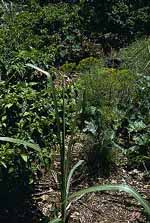System diversity: farm systems based on several cropping systems, cropping systems based on a mixture of crops, and crops with varietal and other genetic variability.
Traditional farmers can often be characterized as managing mixed subsistence economies; employing several cropping systems simultaneously. This includes having plots under continuous cultivation, some in shifting cultivation and also raising animals. This allows for a larger diversity of outputs, greater flexibility and increased system stability. Intercropping is common in traditional agriculture. Rather than growing only one crop in each field, several different crops are planted simultaneously within the same area of land. For example, in Java small-scale farmers have up to 607 crop species in their gardens, equivalent to the species diversity of a deciduous tropical forest (*FAO, 1996).

|
|
|
Traditional farming is also characterized by a high degree of genetic diversity within each crop species. Traditional Sri Lanka farmers planted 280 varieties of rice, Andean farmers planted as many as 50 different varieties of potato in the same year and in the Philippines farmers used more than 300 traditional rice varieties. (Altieri 1987, Zimmerer 1998, *FAO 1996). This practice reduces the threat of crop loss due to a strain of pathogen that is adapted to a specific plant; some of the varieties are sure to be resistant. The diversity is also insurance against losses due to unpredictable weather or changing climatic conditions. If some varieties are susceptible to mildew in wet years, others will surely thrive in those conditions. The genetic diversity within crops provides a steady harvest as different varieties mature at different rates. This ensures the harvest is a continuous process distributing labor demands over a longer time period and providing relatively constant food supplies.